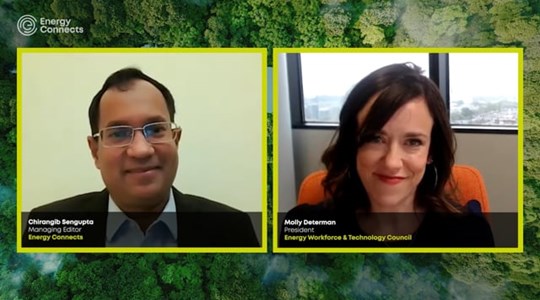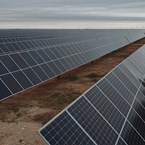EWEC talks investments and energy outlook in MENA
Bruce Smith, the Forecasting & Planning Director at the Emirates Water and Electricity Company (EWEC) talks to Energy Connects about the developments that EWEC is undertaking within the utilities sector. He discusses what the future within the sector looks like.
What are the key highlights of the forecast report on capacity requirements related to water and electricity production?
EWEC’s Statement of Future Capacity Requirements 2021-2027: Summary Report sets out the decision-making process and recommendations regarding the future production capacity requirements for Abu Dhabi and beyond.
Under our base case scenario it is forecast that, as a result of investment made to date in solar photovoltaic (PV) projects, clean energy projects such as nuclear energy, and Reverse Osmosis (RO) desalination coming on-stream in the coming years, expected CO2 emissions will drop to around 20 million tonnes by 2025 from more than 40 million tonnes in 2020.
In addition, we recommend significant investment in new RO desalination capacity. This will not only increase EWEC’s water desalination capacity, but also boost the system efficiency and reduce the overall cost of production by increasing the reserve margin of installed desalination capacity above peak demand from 2022 onwards.
Currently, we do not recommend that any new solar PV projects should be procured during 2021. However, we will continue to keep this recommendation under review as demand evolves over the coming months and years. This will also give the Sector time to consider further changes to operating reserve policy that also affect the economic case for deploying more solar PV.
Under our base case assumptions, further gas-fired investment will also not be required until the late 2020’s.
It is important to note that the statement, published by EWEC and approved by the Abu Dhabi Department of Energy (DoE), is a key reference for all stakeholders as it provides insight into the sector’s capacity planning process and a balanced perspective on what can be achieved and what needs to be done to support Abu Dhabi’s energy transformation towards a more efficient, reliable and sustainable system.
What is your demand forecast for both water and power for the coming years?
In 2020, net electricity demand was just below 15,000 MW and is forecast to gradually rise to reach almost 15,500 MW by 2025.
In 2020, water demand was 3.74milion m3/day (823 million imperial gallons per day [MIGD]) and it is expected to reduce to 3.39million m3/day (747 MIGD) by 2025.
Can you discuss any investment plans in renewable energy or water production going forward?
We are recommending a major investment programme in new Reverse Osmosis (RO) water desalination projects to boost system efficiency and reduce the overall cost of production. This will also increase supply security and, by adopting innovative technology that will result in lower energy-intensive systems, we will be able to reduce our carbon footprint in support of UAE Energy Strategy 2050.
Modelling results support a recommendation for 772,000m3/day (170 MIGD) of additional RO capacity in the system by 2026 to serve existing demand and further increasing the Sector’s decoupling of electricity and water production.
We don’t expect or recommend to add any more solar PV capacity until 2027, unless additional demand is integrated into the system. Nonetheless, to ensure we can respond more quickly if demand rises faster than expected, we will continue to plan to procure additional solar PV capacity of at least 500 MW. However, any decision to proceed with the project will be subject to further analysis as more information becomes available.
What environmental benefits do you expect from future production and how will this be achieved?
The continued introduction of less carbon-intensive technologies such as solar PV, nuclear and RO is anticipated to significantly reduce emissions from power and water production.
We are expecting that investments made to date in solar Photovoltaic (PV) projects, clean energy projects such as nuclear energy, and RO desalination coming on-stream in the coming years, will result in CO2 emissions being reduced to around 20 million tonnes by 2025 from more than 40 million tonnes in 2020, a saving equivalent to taking 4 million cars off the roads. Increased demand or integration with other entities will further improve our ability to decarbonise the sector.
EWEC’s new investments will also result in the decoupling of Abu Dhabi’s power and water sector, boosting energy consumption efficiencies and therefore further reducing carbon emissions. Because RO plants use a fraction of the energy to desalinate water compared to thermal plants, it becomes the linchpin for the whole sector decarbonisation.
RO comes at such a cost and efficiency advantage that the all-in costs of building and operating new RO is less than a third of the all-in price of water from thermal desalination. Critically, by building RO we free up space on the electricity side, in turn allowing more cost-competitive and carbon-friendly power technologies to enter.
As existing thermal cogeneration plants reach the end of their contract the desalination component will be retired. By some time in the 2030’s we expect all water production to be from membrane based technology.
What other steps is EWEC taking to reduce carbon footprint and supporting the UAE Energy Strategy 2050?
EWEC has already implemented strategic plans that have reduced emissions. The company’s average CO2 intensity from electricity generation fell in 2018 to 350g per kilowatt-hour (kWh), 15 percent down from 412g/kWh in 2015 due to the commissioning of new energy-efficient plants. The rate achieved is already 30 percent lower than that of the OECD country average.
We are committed to supporting the government’s UAE Water Security Strategy 2036 and UAE Energy Strategy 2050 to help it achieve its goals to reduce the energy sector’s carbon footprint. As we forecast water and electricity demands over the coming years, we can see that with strategic investment in renewable and clean energy technologies we can ensure the UAE is on track to continue to reduce its emissions in the energy sector.
By 2030, EWEC is working to produce over 50 percent of Abu Dhabi’s energy needs from renewable and clean energy sources and, at the same time, reduce the average carbon intensity of the system by more than 70 percent compared to 2015.
What industry-wide trends have you seen or forecast post-pandemic?
A major trend that will impact the future of solar energy use is the growth of energy storage solutions. Energy storage solutions, such as batteries, are going to become an integral part of the future energy mix, especially because of the amount of renewable energy being injected into regional grids.
Our modeling suggests that, at current prices, the combined value of batteries from providing capacity adequacy, and in particular operating reserves, is close to reaching a tipping point that will justify starting the procurement of new storage investments in the near term.
However, we will keep battery and other technology costs under review to identify the point at which their future deployment is justified.
Accelerated decoupling of water and power reduction has clear benefits, and may create value by allowing thermal cogeneration plants to be replaced by new RO plants, which are more efficient and less energy intensive.
In the coming months we will release our next Statement of Future Capacity Requirements Summary Report, which will outline additional recommendations regarding the future system requirements, and expected trends.
KEEPING THE ENERGY INDUSTRY CONNECTED
Subscribe to our newsletter and get the best of Energy Connects directly to your inbox each week.
By subscribing, you agree to the processing of your personal data by dmg events as described in the Privacy Policy.

Energy Workforce helps bridge the gender gap in the industry
Mar 08, 2024
EGYPES Climatech champion on a mission to combat climate change
Mar 04, 2024
Fertiglobe’s sustainability journey
Feb 29, 2024
P&O Maritime Logistics pushing for greater decarbonisation
Feb 27, 2024
Neway sees strong growth in Africa
Feb 27, 2024
India’s energy sector presents lucrative opportunities for global companies
Jan 31, 2024
Oil India charts the course to ambitious energy growth
Jan 25, 2024
Maritime sector is stepping up to the challenges of decarbonisation
Jan 08, 2024
COP28: turning transition challenges into clean energy opportunities
Dec 08, 2023
Why 2030 is a pivotal year in the race to net zero
Oct 26, 2023Partner content

Ebara Elliott Energy offers a range of products for a sustainable energy economy

Essar outlines how its CBM contribution is bolstering for India’s energy landscape

Positioning petrochemicals market in the emerging circular economy

Navigating markets and creating significant regional opportunities with Spectrum





























